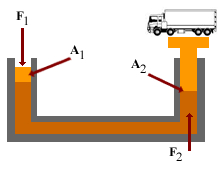| Pascal's law — developed by French mathematician Blaise Pascal — states that when there is an increase in pressure at any point in a confined fluid, there is an equal increase at every other point in the container. | |
Definition of pressure: If F is the magnitude of the normal force on the piston and A is the surface area of a piston, then the pressure, P, of the fluid at the level to which the device has been submerged as the ratio of the force to area. | |
 | |
Since the pressure is force per unit area, it has units of N/m2 in the SI system. Another name for the SI unit of pressure is Pascal (Pa) | |
 | |
An important application of Pascal's law is the hydraulic press. A force F1 is applied to a small piston of area A1. The pressure is transmitted through a liquid to a larger piston of area A2. Since the pressure is the same on both sides, we see that P = F1/A1 = F2/A2. Therefore, the force F2 is larger than F1 by multiplying factor A2/A1. Hydraulic brakes, car lifts, hydraulic jacks, and forklifts all make use of this principle. | |
 | |
Style2
Style3[OneLeft]
Style3[OneRight]
Style4
Style5
Tagged with: Engineering/Science Laws
About engineer eye
This is a short description in the author block about the author. You edit it by entering text in the "Biographical Info" field in the user admin panel.
Subscribe to:
Post Comments (Atom)
- Popular Post
- Video
- Category
Pel�culas populares
-
A compound wound dc motor or rather a dc compound motor falls under the category of self excited motors, and is made up of both series ...
-
Welcome to this open and free electrical engineering study site. A strong team of well experienced electrical engineers in different fields...
-
RC PLANE DESIGN Wing design Explanation We used Dihedral wing, which helps to increase the gliding time with less battery charge. ...
-
Use these tips and instructions for adding new electrical wiring. Take a few minutes to read the directions thoroughly. Foll...
-
Definition of the ampere : If two long, parallel wires 1 m apart carry the same current and the force per unit length on each wire is 2x10 ...
-
These force laws, together with the laws of motion, are the foundations of classical mechanics. They are based on experimental observations...
-
Shortly after Oersted's discovery in 1819 that a compass needle is deflected by a current-carrying conductor, Jean Baptist Biot and F...
-
Insulation Resistance of Cable Joules Laws of Heating Laws of Resistance What is conductivity? Working Principle of DC Motor Working Pr...
-
Ohm's law was named after George Simon Ohm (1787 — 1854). It states that for many materials (including most metals), the ratio of the...
No comments: